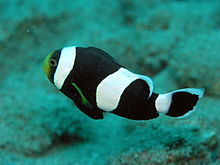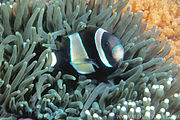Saddleback clownfish
| Saddleback clownfish | |
|---|---|

| |
| Scientific classification | |
| Domain: | Eukaryota |
| Kingdom: | Animalia |
| Phylum: | Chordata |
| Class: | Actinopterygii |
| Family: | Pomacentridae |
| Genus: | Amphiprion |
| Species: | A. polymnus
|
| Binomial name | |
| Amphiprion polymnus | |
| Synonyms | |
| |
Amphiprion polymnus, also known as the saddleback clownfish or yellowfin anemonefish, is a black and white species of
Description
A. polymnus is a small sized
Color variations
Melanistic variation has also been partially correlated with the fish's host anemone. Specimens associated with
Similar species
Historically anemonefish have been identified by morphological features, color pattern in the field, while in a laboratory other features such as scalation of the head, tooth shape and body proportions.[4] These features have been used to group species into complexes and A. polymnus is part of the saddleback complex with A. sebae and A. latezonatus.[7] Genetic analysis has shown that A. latezonatus did not fit within this clade and has a monospecific lineage.[8][9] The yellow tail of A. sebae distinguishes that species from A. polymnus.[4]
-
A. polymnus showing the similar sizes of male and female.
-
A. sebaeis distinguished by its yellow tail.
-
A group of saddleback anemonefish over Stichodactyla haddoni from East Timor.
Distribution and habitat
A. polymnus is found in the center of the Indo-Pacific area, known as the Coral Triangle, from the Philippines to Indonesia and New Guinea.It is also found in northern Australia, Melanesia and to the Ryukyu Islands of southern Japan.[4] Adults inhabit silty lagoons and harbour areas in depth range from 2 to 30 metres (6.6 to 98.4 ft).[10][11]
Host anemones
The relationship between anemonefish and their host sea anemones is not random and instead is highly nested in structure.[12] A. polymnus is a specialist, being hosted by 2 out of the 10 host anemones: [4][11][12]
- Heteractis crispaSebae anemone (rarely)
- Stichodactyla haddoni (Saddle carpet anemone)
Diet
Like all anemonefish, A. polymnus is
Behaviour
A. polymnus has a diurnal activity, is aggressively territorial and is dependent on its host sea anemone which it uses as a shelter for the group and for the nest. The anemonefish can also defend the anemone against some reef fishes which could eat the tentacles such as butterflyfishes.[6] Both species of sea anemone, which host A. polymnus, are known to bury themselves in the sand when they are under stress, leaving the fish vulnerable to predation. It has been suggested that the almost equal size of the male is an adaptation to allow it to elude predators by erratic swimming in the water column or covering the relatively long distance to shelter in coral rubble.[14]
Conservation status
Anemonefish and their host anemones are found on coral reefs and face similar environmental issues. Like corals, anemones contain intracellular endosymbionts, zooxanthellae, and can suffer from bleaching due to triggers such as increased water temperature or acidification. The other threat to anemonefish is collection for the marine aquarium trade where anemonefish make up 43% of the global marine ornamental trade, and 25% of the global trade comes from fish bred in captivity, while the majority are captured from the wild,[15][16] accounting for decreased densities in exploited areas.[17] While bleaching is a significant threat to anemonefish and their host anemones, there is evidence suggesting that collection compounds the localised impact of bleaching.[18] This species was not evaluated in the 2012 release of the IUCN Red List.
In the aquarium
A. polymnus has been bred in captivity.
References
- .
- ^ Bailly N, ed. (2014). "Amphiprion polymnus (Linnaeus, 1758)". FishBase. World Register of Marine Species.
- PMID 15252999.
- ^ ISBN 9780730983651. Archived from the originalon 18 October 2014.
- ISBN 9780691089959.
- ^ a b c "Amphiprion polymnus". Encyclopedia of Life.
- ^ Goemans, B. "Anemonefishes". Retrieved 20 September 2015.
- PMID 23122007.
- ^ DeAngelis, R. "What we really know about the diversity of Clownfish". Retrieved 20 September 2015.
- ISBN 9783882440089.
- ^ a b Bray, Dianne. "Saddleback Anemonefish, Amphiprion polymnus". Fishes of Australia. Retrieved 4 October 2015.
- ^ PMID 17476781.
- ISBN 978-2-7114-1525-0.
- .
- ISBN 978-94-007-6015-8.
- ^ Taylor, M.; Green, E. & Razak, T. (2003). From ocean to aquarium: A global trade in marine ornamental species (PDF). UNEP world conservation and monitoring centre (WCMC). pp. 1–64. Retrieved 18 April 2013.
- S2CID 25027153.
- .
External links
- "Amphiprion polymnus". Integrated Taxonomic Information System. Retrieved 23 August 2007.
- Amphiprion polymnus. Linnaeus, 1758. Retrieved through: World Register of Marine Species.
- "Saddleback Clownfish (Amphiprion polymnus) Profile". saltaquarium.about.com.
- Photos of Saddleback clownfish on Sealife Collection





